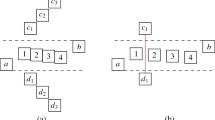Abstract
LetP be a set ofl points in 3-space, and letF be a set ofm opaque rectangular faces in 3-space with sides parallel tox- ory-axis. We present anO(n logn) time andO(n) space algorithm for determining all points inP which are visible from a viewpoint at (0,0,∞), wheren=l+m. We also present anO(n logn+k) time andO(n) space algorithm for the hidden-line elimination problem for the orthogonal polyhedra together with a viewpoint at (0,0,∞), wheren is the number of vertices of the polyhedra andk is the number of edge intersections in the projection plane.
Similar content being viewed by others
References
Asano Ta, Asano Te, Guibas L, Hershberger J, Imai H (1986) Visibility of disjoint polygons. Algorithmica 1:49–63
Avis D, Toussaint GT (1981) An optimal algorithm for determining the visibility of a polygon from an edge. IEEE Trans Comput C30:910–914
Bentley JL, Wood D (1980) An optimal worst-case algorithm for reporting intersections of rectangles. IEEE Trans Comput C-29:571–577
Chazelle B (1983) Filtering search: A new approach to query answering. Proc 24 th IEEE Ann Symp Foundat Comput Sci, pp 122–132
Chazelle B, Guibas L (1985) Visibility and intersection problems in plane geometry. Proc Symp Computational Geometry, Baltimore, pp 135–146
Chazelle B, Incerpi J (1983) Unraveling the segment tree. Tech Rep TR-CS-83-15, Brown University
Davis L, Benedikt M (1979) Computational models of space: Isovists and isovist fields. Comput Graph Image Proc 11:49–72
Dévai F (1986) Quadratic bounds for hidden line elimination. Proc 2nd Symp Computational Geometry, Yorktown Heights, New York, pp 269–275
Edelsbrunner H, Overmars MH, Wood D (1983) Graphics in flatland: a case study. In: Preparata FP (ed) Advances in Computing Research 1. JAI Press, pp 35–59
ElGindy H (1985) Hierarchical decomposition of polygons with applications. PhD Thesis, McGill University
ElGindy H, Avis D (1981) A linear algorithm for computing the visibility polygon from a point. J Algorithms 2:186–197
Freeman H, Loutrel PP (1967) An algorithm for the two-dimensional “hidden line” problem. IEEE Trans Electronic Computers EC-16(6):784–790
Guibas L, Hershberger H, Leven L, Sharir M, Tarjan RE (1986) Linear time algorithms for visibility and shortest path problems inside polygons. Proc 2nd Symp Computational Geometry, Yorktown Heights, New York, pp 1–13
Güting RH, Ottmann Th (1985) New algorithms for special cases of the hidden line elimination problem. Computer Vision, Graphics, and Image Processing 40:188–204
Harel D, Tarjan RE (1984) Fast algorithms for finding nearest common ancestors. SIAM J Comput 13:338–355
Joe B, Simpson RB (1987) Algorithms and correctness proofs for visibility polygon computations. Tech Rep CS-87-03, University of Waterloo, Waterloo, Ontario, Canada
Lee DT (1983) Visibility of a simple polygon. Computer Vision, Graphics, and Image Processing 22:207–221
Lee DT, Chen IM (1985) Display of visible edges of a set of convex polygons. In: Toussaint GT (ed) Computational Geometry. North-Holland, pp 249–265
Lee DT, Lin A (1984) Computing the visibility polygon from an edge. Tech Rep, Northwestern University
Nilsson NJ (1969) A mobile automation: An application of artificial intelligence techniques. Proc IJCAI-69, pp 509–520
Ottmann Th, Widmayer P, Wood D (1985) A worst-case efficient algorithm for hidden line elimination. Int J Comput Math 18:93–119
Sack JR (1984) Rectilinear computational geometry. PhD Thesis, School of Computer Science, Carleton University, Ottawa, Ontario, Canada
Schmitt A (1981) On the time and space complexity of certain exact hidden line algorithms. Tech Rep 24/81, Fakultät für Informatik, University of Karlsruhe
Shin SY (1986) Visibility in the plane and its related problems. PhD Thesis, University of Michigan
Sutherland IE, Sproul RF, Schumacker RA (1974) A characterization of ten hidden-surface algorithms. Computing Surveys 6(1):1–55
Tarjan RE, Van Wyk C (1986) AnO(n log logn) algorithm for triangulating simple polygons. Tech Rep CS-TR-052-86, Princeton University
Toussaint GT (1985) Movable separability of sets. In: Toussaint GT (ed) Computational Geometry. North-Holland pp 335–375
Vaishnavi V, Wood D (1982) Rectilinear line segment intersection layered segment trees, and dynamization. J Algorithms 3:160–176
Author information
Authors and Affiliations
Rights and permissions
About this article
Cite this article
Doh, JI., Chwa, KY. Visibility problems for orthogonal objects in two-or three-dimensions. The Visual Computer 4, 84–97 (1988). https://doi.org/10.1007/BF01905560
Issue Date:
DOI: https://doi.org/10.1007/BF01905560




